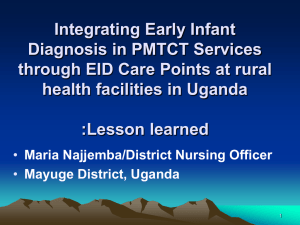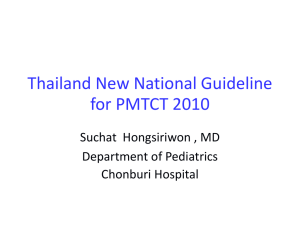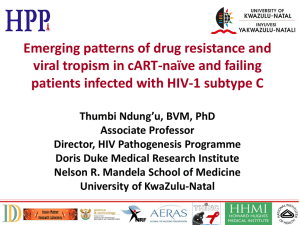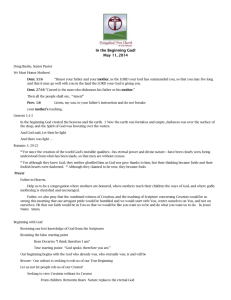Quantification for ARVs PMTCT
advertisement
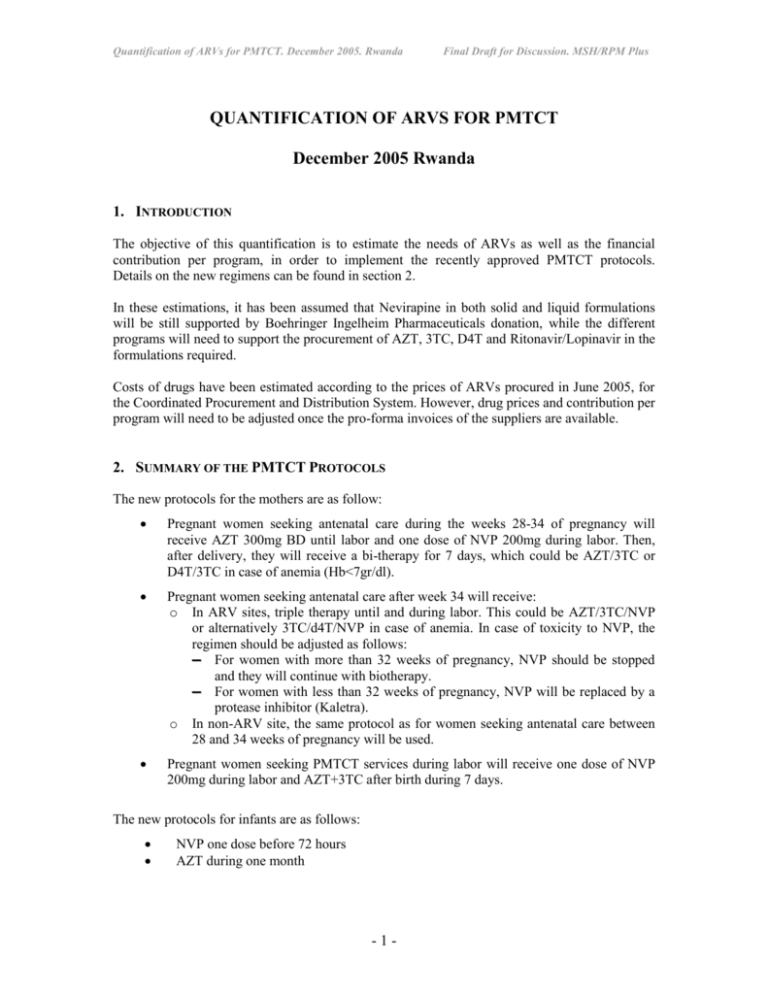
Quantification of ARVs for PMTCT. December 2005. Rwanda Final Draft for Discussion. MSH/RPM Plus QUANTIFICATION OF ARVS FOR PMTCT December 2005 Rwanda 1. INTRODUCTION The objective of this quantification is to estimate the needs of ARVs as well as the financial contribution per program, in order to implement the recently approved PMTCT protocols. Details on the new regimens can be found in section 2. In these estimations, it has been assumed that Nevirapine in both solid and liquid formulations will be still supported by Boehringer Ingelheim Pharmaceuticals donation, while the different programs will need to support the procurement of AZT, 3TC, D4T and Ritonavir/Lopinavir in the formulations required. Costs of drugs have been estimated according to the prices of ARVs procured in June 2005, for the Coordinated Procurement and Distribution System. However, drug prices and contribution per program will need to be adjusted once the pro-forma invoices of the suppliers are available. 2. SUMMARY OF THE PMTCT PROTOCOLS The new protocols for the mothers are as follow: Pregnant women seeking antenatal care during the weeks 28-34 of pregnancy will receive AZT 300mg BD until labor and one dose of NVP 200mg during labor. Then, after delivery, they will receive a bi-therapy for 7 days, which could be AZT/3TC or D4T/3TC in case of anemia (Hb<7gr/dl). Pregnant women seeking antenatal care after week 34 will receive: o In ARV sites, triple therapy until and during labor. This could be AZT/3TC/NVP or alternatively 3TC/d4T/NVP in case of anemia. In case of toxicity to NVP, the regimen should be adjusted as follows: ▬ For women with more than 32 weeks of pregnancy, NVP should be stopped and they will continue with biotherapy. ▬ For women with less than 32 weeks of pregnancy, NVP will be replaced by a protease inhibitor (Kaletra). o In non-ARV site, the same protocol as for women seeking antenatal care between 28 and 34 weeks of pregnancy will be used. Pregnant women seeking PMTCT services during labor will receive one dose of NVP 200mg during labor and AZT+3TC after birth during 7 days. The new protocols for infants are as follows: NVP one dose before 72 hours AZT during one month -1- Quantification of ARVs for PMTCT. December 2005. Rwanda Final Draft for Discussion. MSH/RPM Plus 3. ESTIMATION OF ARV NEEDS Procurement period The calculations have been made in order to estimate the needs of ARVs for PMTCT for the period January to July 2006, since it is expected that the new protocol will start in December 2005. In addition a three-month security stock has been added, which will cover the period August to October 2006. Estimation of number of new sites opening per month According to data collected from April to September 2005 (see table below), the average number of new PMTCT sites opening per month is 10. Month Number of Sites April-05 150 Sept-05 199 Total Months 5 Average number of New Sites Opened per Month 10 Estimation of mothers treated per site and month In the absence of more accurate information, it has been assumed that the number of mothers treated per month in each PMTCT site is constant over time, and that the number of mothers treated per site is similar all over the country. The data available used for the estimations are: Number of mothers treated during 2003 = 2,886 Number of sites opened in 2003 = 56 Number of mothers treated by the end of 2004 = 6,404 Number of sites operational by the end of 2004 = 120 Therefore, it can be estimated that each site treats an average number of 55 women per year, which makes around 4.58 mothers treated per site and per month. -2- Quantification of ARVs for PMTCT. December 2005. Rwanda Final Draft for Discussion. MSH/RPM Plus Estimation total mothers treated per month (January 2006 to October 2006) The table below shows the total number of mothers that will be treated per month, with an average increase of 10 new sites per month, and 4.58 mothers treated per month and per site. Nov 05 Dec 05 Jan 06 Feb 06 Mar 06 Apr 06 May 06 Jun 06 Jul 06 Aug 06 Sep 06 Oct 06 Projected PMTCT Sites 208 218 227 237 246 256 266 275 285 294 304 314 Mothers per Month 953 997 1041 1085 1129 1173 1217 1261 1305 1349 1393 1437 12,389 women to be treated Estimation of total number of mothers treated for the procurement period (Jan to Oct 2006) The total number of mothers treated for the period January to October 2006 can be estimated from the table above, by aggregating the number of mothers treated per month, which makes a total of 12,389. Estimation of % of mothers seeking PMTCT services per week of pregnancy and average number of days of treatment The table below shows the distribution of mothers seeking treatment in PMTCT clinics according to the week of pregnancy. Week of Pregnancy Mother Presents at PMTCT Site % of Mothers Days of treatment needed according to week 28 70 84 30 5 70 32 5 56 34 5 42 36 5 28 38 5 14 40 5 1 -3- Groups of mothers Adjusted average of number of days of treatment for each group 80% 84 15% 42 5% 1 Quantification of ARVs for PMTCT. December 2005. Rwanda Final Draft for Discussion. MSH/RPM Plus Since the number of days of treatment and therefore the drug requirements will depend on the week when the treatment is started, for quantification purposes it has been considered always the highest number of days of treatment in each group. Therefore, in average it can be concluded that: 80% of the mothers seeking antenatal care will be between 28 and 34 weeks of pregnancy, needing 84 days treatment. 15% of the mothers seeking antenatal care will be between 34 and 40 weeks of pregnancy, needing 42 days treatment. 5% of the mothers will seek antenatal care at delivery, needing 1 day of treatment. Assumptions Percentage of anemic mothers. Since there is no data available on actual prevalence of anemia in pregnant women in Rwanda, for this quantification it has been assumed that 35% of anemia in pregnant women, based in two sources: o The document Elaboration de la Politique Nationale de Nutrition (December, 2004) states that according to a survey done by the Ministry of Health in 1996, the rate of anemia of pregnant women was 10.6%. However, this rate seems not to be very realistic since Sub-Saharan countries show rates 3 times higher1. o The study The prevalence and Factor Associated with Pregnancy at CHK, (March 2002), estimates a rate of anemia of 32.4% among 380 pregnant women seeking antenatal care. Since the population of CHK may not be representative of rural areas, it has been assumed that the rate of anemic women in the country might be a bit higher. Percentage of pregnant women < 60 kg. According to a study carried out by TRAC in the Gitega health center, Kicukiro health center and Muhima hospital, it has been estimated that 38% of pregnant women’s weight is below 60kg and 62% is above 60kg. This percentage has been used to calculate needs for D4T 30mg and D4T 40mg for anemic mothers. Toxicity to NVP. There is no data available on toxicity to NVP in Rwanda. However, several studies2 have found that women with CD4 >350 have higher risk to develop toxicity to NVP. Data collected during 2004 on pregnant women from Kicukiro Health Centre suggest that around 16% of the pregnant women who are HIV positive will have a CD4 count > 350 (see table below). According to the protocols, since not all HIV positive pregnant women will have a NVP-based regimen, it has been estimated that around 2.5% from the total number of women will need to be changed to the Kaletra based regimen. L’Enquête nationale de nutrition, menée en 1996 par le Ministère de la Santé, a dépisté 43,1 % de taux de prévalence de l’anémie (Hgb < 11 g) chez les enfants de 0 à 5 ans et 10,6 % chez les femmes enceintes. Le taux de prévalence de 10,6 % chez les femmes enceintes est 3 fois plus bas que celui généralement observé dans les pays de l’Afrique sub-saharienne et semble peu refléter la réalité. Elaboration de la Politique Nationale de Nutrition. December 2004. p.6 2 Ask references to TRAC. 1 -4- Quantification of ARVs for PMTCT. December 2005. Rwanda Final Draft for Discussion. MSH/RPM Plus Data from Kicukiro Health Clinic (2004) Number of women in PMTCT 97 CD4 < 250 % Women in PMTCT 76% CD4 between 250 and 350 10 8% CD4 > 350 20 16% Total 127 100% Number of infants treated. Data from the TRAC gathered during 2004 suggest that every 100 mothers treated to prevent the transmission of HIV to the child, only 84.5 infants are treated (2,939 mothers treated versus 2,490 infants). This suggests that there are a number of children who do not receive the treatment after birth. For the estimations in this exercise it has been agreed to consider that the PMTCT services will improve, and that the number of children receiving treatment will be equal to the number of mothers (= 12,389), assuming that only one baby will be born from each mother. The average weight of new born has been estimated to be 3kg. Needs of ARVs for Mothers The table below shows the results on the requirements of ARVs for the treatment of mothers in PMTCT programs. PACK UNIT NUMBER OF TABLETS NUMBER OF BOXES AZT 300mg tab 60 1,082,270 18,038 NVP 200mg tab 60 166,627 2,777 LPV/r tab 180 24,975 139 AZT+3TC tab 60 216,615 3,610 D4T 30+3TC+NVP tab 60 221,460 3,691 D4T 40+3TC+NVP tab 60 361,320 6,022 D4T 30 mg caps 56 44,296 791 D4T 40mg caps 56 72,296 1,291 3TC tab 60 116,639 1,944 PRODUCT -5- Quantification of ARVs for PMTCT. December 2005. Rwanda Final Draft for Discussion. MSH/RPM Plus Needs of ARVs for Infants The table below shows the results on the requirements of ARVs for the treatment of infants in PMTCT programs. Days ml Waste per Infant Total ml ml per Bottle 2 30.5 26.8 100.0 1 1 0.4 1 Dose (ml/kg) Infant Weight Daily dose AZT Syrup 0.4 3 NVP Syrup 0.2 3 Bottles Numbers of infants to be treated Numbers of bottles 100 1 12,389 12,389 20 0.05 12,389 619 1. In the case of AZT syrup, a bottle of 100 ml will be enough to treat each infant. Since it is not possible to break bottles and the treatment will be most likely followed at home, it has been therefore estimated that it will be needed one bottle of AZT syrup for children treated (=12,389). 2. For the case of NVP syrup, each child will receive an only dose of treatment, which is most likely to be administered in the health center or hospital. Since it is expected that wastage of liquid will occur, it has been estimated that for each child treated it will be needed an average on 1ml of syrup, making a total number of 619 bottles. -6- Quantification of ARVs for PMTCT. December 2005. Rwanda Final Draft for Discussion. MSH/RPM Plus 4. ESTIMATION OF QUANTITIES TO BE ORDERED AND COSTS FOR PMTCT Estimation of Quantities to be ordered and Total Costs The table below shows the quantities to be ordered taking into account the quantities in stock and quantities on order. The final column shows the cost of the product, according to the prices gathered from the suppliers in the last procurement placed. These prices will be updated once proforma invoices from suppliers are received. Pack prices Total needs ( tablets or ml) Stock on hand (end of September) Stock on order Quantity to order ( bottles and boxes) Total prices AZT 300mg/ tab $15.47 1,082,270 0 0 18,038 $279,085.08 AZT syrup/ml $7.70 1, 238,863 0 0 12,389 $95,441.98 D4T30+3TC+NVP/ tab $13.32 221,460 0 0 3,691 $49,167.26 D4T40+3TC+NVP/tab $14.49 361,320 0 0 6,022 $87,243.56 AZT+3TC/ tab $16.05 216,615 0 0 3,610 $57,944.55 D4T 30mg /caps $3.46 44,296 0 0 791 $2,735.43 D4T 40mg/ caps $3.48 72,296 0 0 1,291 $4,490.70 3TC 150mg/ tab $5.72 116,639 0 0 1,944 $11,128.33 LPV/r /tab $47.67 24,975 0 0 139 $7,077.34 NVP syrup/ml Free 12,389 0 2,400 500 N/A NVP 200mg/tab Free 166,627 0 3,000 2,727 N/A TOTAL COST $594,314.22 Prices per Box or Bottle of Product3 AZT+3TC $ 16.05 AZT 300 mg $ 15.47 D4T 30mg $ 3.46 AZT syrup $ 7.70 D4T 40mg $ 3.48 D4T30+3TC+NVP $ 13.32 3TC $ 5.72 D4T40+3TC+NVP $ 14.49 Ritionavir/lop $ 51.01 AZT+3TC $ 16.05 3 Prices used according to the procurement placed in June 2005. Need to be adjusted. -7- Quantification of ARVs for PMTCT. December 2005. Rwanda Final Draft for Discussion. MSH/RPM Plus Estimation of Contribution per Program according to Number of Sites The following table shows the contribution per program based on the number of sites that each program is supporting. It has been assumed that the % of sites that each program will support will be maintained over the following months. Adjustments could be made if more accurate information regarding targets and ceilings on patients and number of sites is facilitated by the different contributors. # of Sites % of Total Contribution per program USD COAG (TRAC/CDC) 2 1% $5,973.01 Concern (Global Fund) 1 0.5% $2,986.50 E.P.R (FHI / IMPACT) 1 0.5% $2,986.50 EGPAF 18 9.0% $53,757.07 FHI 25 12.6% $74,662.59 Global Fund 107 53.8% $319,555.89 IntraHealth 19 9.5% $56,743.57 MSF Belgique 2 1.0% $5,973.01 OMS 5 2.5% $14,932.52 UNICEF 16 8.0% $47,784.06 AVSI 1 0.5% $2,986.50 MAP 1 0.5% $2,986.50 Med. M (Global Fund) 1 0.5% $2,986.50 199 100% $594,314.22 Total -8- Quantification of ARVs for PMTCT. December 2005. Rwanda Final Draft for Discussion. MSH/RPM Plus 5. OBSERVATIONS AND RECOMMENDATIONS A successful implementation of the new PMTCT protocols will require to put in place a good monitoring system to gather systematically information from the sites on mothers developing toxicity to NVP, and on % of mothers seeking PMTCT services with anemia. In addition, it will be also necessary to gather data on the number of mothers under each of the different regimens, in order to monitor the adherence of the clinicians to the new protocols. If clinicians do not adhere to the protocols, the theoretical estimations of drugs based on population data will not correspond to real consumption. More accurate information concerning the number of mothers and infants expected to be treated by site and program will allow a better estimation of the contribution by program. Although the average number of mothers treated by site might provide enough information to estimate national needs of ARVs for PMTCT, this information is insufficient in order to develop a plan for distribution of products by site and by program. -9-

